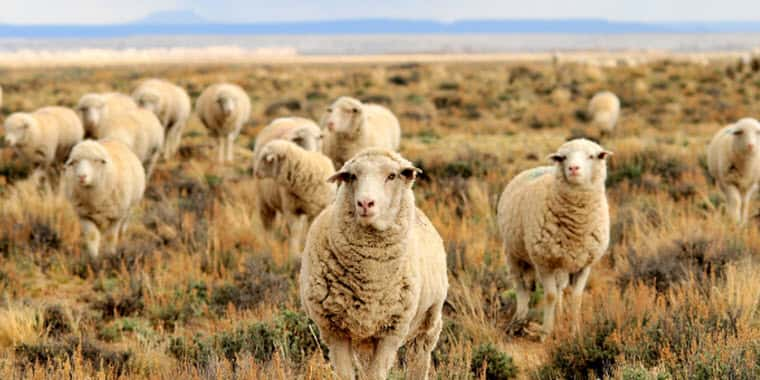Helping each sheep producer find ways to be more efficient plus take more control of flock productivity, both of which protect against price volatility, is the bottom-line reason for the Best Practices to Increase Your Lamb Crop fact sheets. The series is a joint effort of the American Lamb Board (ALB) and the American Sheep Industry Association’s Let’s Grow program.
Best practices are a cornerstone of many industries – from computer manufacturing to education – and guide processes to achieve a desired result. For the lamb industry, Productivity Best Practices identify ways to produce more with comparable resources, which is a critical component of profitability. After all, lambs sold per ewe is still the biggest influencer of profitability.
Even though sheep production practices in the U.S. vary widely, there are lamb crop best practices that will benefit every flock. Most sheep producers will be able to identify at least 3 of the 12 best practices that will help them gain efficiency and improve profitability.
Key indicators have also been developed to help identify which lamb crop best practices will be most beneficial for various production styles.
Below is a brief overview of the 12 lamb crop best practices:
Optimal Nutrition
Prior to breeding, ewes should be fed a ration that puts them on track for appropriate weight gain. When breeding ewes, they should have a body condition score of 3 or slightly less. Throughout gestation, be sure to meet the nutritional requirements of your bred ewes. Following lambing and through weaning, maintain ewes on quality feed that takes into account factors such as the number of lambs they are rearing. At any stage of production, consider sorting ewes into groups based on body condition in order to allocate feed to dietary needs.
Breed Ewe Lambs at 7 to 9 Months of Age
If managed properly, ewe lambs should be able to lamb at or near their first birthday. Ewes that give birth to their first lamb before they are yearlings tend to be more productive throughout their lifetime compared to those that first lamb as yearlings. When considering this best practice, keep in mind that different breeds of sheep vary in age of puberty.
Select for Prolific Genetics
Select for prolific genetics within rams that produce offspring you will be considering for replacements. Similarly, replacement ewe lambs should be selected from high performing dams. Estimated breeding values (EBVs) produced by the National Sheep Improvement Program (NSIP) are an excellent tool to accomplish this goal.
Use Crossbreeding
First-cross lambs tend to have a 5% higher survival rate than straight-bred lambs, given that genetics are matched with environment. In addition, first-cross ewes tend to have higher lamb crops than purebred sheep.
Cull Underperforming Ewes
Identify and cull ewes that fail to rear a lamb, rear a single-born lamb that is below average in quality and/or weight, fail to rear twins, or lamb outside the first or second heat cycle. Exceptions may be made for reasons outside the ewe’s control.
Reduce Lamb Loss
Postnatal lamb loss should be kept below 10% of all lambs born. Identify best management practices for flock health, predator prevention, protection from severe weather conditions, and other factors that will improve lamb survival. Most non-predator lamb loss occurs within the first week, so management decisions during this time period can have large impacts on flock profitability.
Test for Pregnancy Status
Determine pregnancy status via ultrasound. Cull open ewes or market ewe lambs prior to lambing season. Group and feed ewes according to the number of lambs they are raising and stage of pregnancy.
Disease Prevention and Treatment
Work with your veterinarian or consultant to develop an overall health management plan to prevent or eradicate disease, such as aborting agents or chronic disease, which have a negative impact on reproductive efficiency.
Match Reproduction to Management
Your goals for flock reproductive efficiency will vary depending on nutritional and labor resources. However, increasing reproductive efficiency should be a primary goal for most flocks.
Test Rams
Don’t overlook ram fertility. Check all rams using a general breeding soundness exam 30 to 60 days prior to breeding. Semen test all rams, or at least any rams that are suspect following a physical exam. Observing rams for breeding activity is another consideration.
Manage for Seasonal Changes in Reproduction
Pregnancy and lambing rate are reduced in ewes that are bred outside the normal breeding season. Ovulation rates peak during October and November in the northern hemisphere. Genetics, improved nutritional management, ram effect, light treatment, and/or hormone therapy can assist in meeting aseasonal breeding goals.
Accelerate Lambing Cycles
For flocks with management practices which allow for more than one lambing season per year, accelerated lambing can improve reproductive efficiency. There are multiple accelerated lambing programs. Identify the program that fits your flock and resources.
The entire set of fact sheets, compiled into one document, can be downloaded here.


